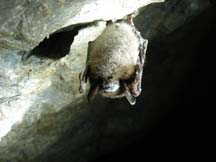 If your state has not yet been struck by white nose syndrome (WNS), or if you are in an area of your state not yet struck by WNS, you’ve probably needed to develop a system of surveillance that isn’t intrusive on hibernating bats and doesn’t take up a ton of staff time.
If your state has not yet been struck by white nose syndrome (WNS), or if you are in an area of your state not yet struck by WNS, you’ve probably needed to develop a system of surveillance that isn’t intrusive on hibernating bats and doesn’t take up a ton of staff time.
The favored method of WNS surveillance — sending staffers to known bat hibernation sites to observe and survey bats — is both intrusive and time consuming.
Scientists from the National Parks Service and the Southeastern Cooperative Wildlife Disease Study describe a new surveillance concept in a letter to the journal Emerging Infectious Diseases.
To survey the region around Mammoth Cave National Park, the national park service used bats that had previously been collected for rabies testing and had been proven not to have rabies.They narrowed their search by testing only bat species known to be susceptible to WNS and only those collected from November to April, when WNS is more likely to be detectable.
In a pilot test, the technique did detect one WNS-positive bat.
Read the letter to Emerging Infectious Diseases, here.
It’s important to keep in mind that the external parts of the WNS fungus can be brushed off at any contact, so that the tell-tale fuzzy white fungus may not be visible on bats that have been previously handled.
This Journal of Veterinary Diagnostic Investigation paper tells you what the lab should be looking for under the microscope. There is also a PCR test for the fungus.
Photo: Bat with white nose syndrome in a mine in Vermont. Courtesy US Fish and Wildlife Service
